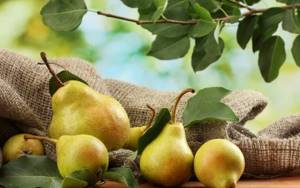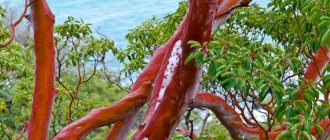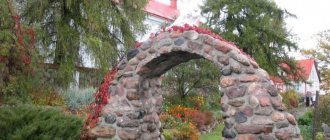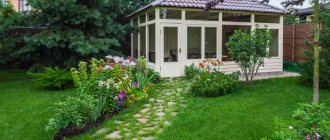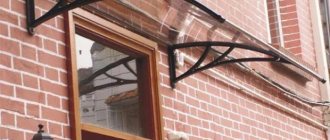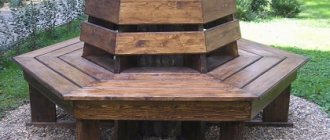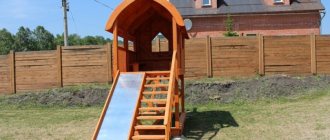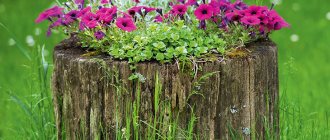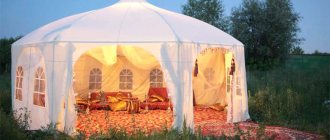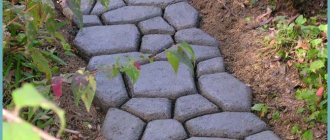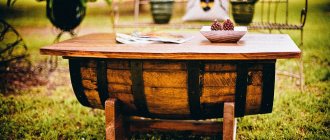Classification
Pear trees are:
- dwarf (2.5-3 m);
- short (up to 4.5 m);
- medium height (4.5-5 m);
- tall (over 5-6 m).
The crown has different shapes: pyramidal, columnar, round. Based on frost resistance, winter-hardy and non-winter-hardy species are distinguished. The purpose also differs - in addition to the fruit group, the decorative group is also widely represented. According to the method of pollination, plants are:
- self-fertile - your own pollen is enough for pollination;
- partially self-fertile - in small quantities, fruits set like self-fertile ones, but cross-pollination is required for a good harvest;
- self-sterile - pollination is possible only with pollen from another pollinator.
Related article:
Pear Skorospelka from Michurinsk
Pears differ in fruit size - they can be large-fruited or small-fruited. Ripening occurs at different times - summer, autumn and winter types are distinguished. The taste characteristics and consistency of the pulp are not the same - the fruits are classified as sweet, sweet and sour and tart, hard and soft.
Landing Features
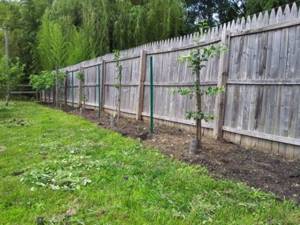
There should be enough free space between trees
It is better to plant pears in the fall, at the end of September. Studies have shown that such seedlings take root better than those planted in the spring. Such trees become more resistant to weather changes, diseases and pests.
But autumn planting also has its drawbacks. A tree that is not yet strong can become food for rodents and receive significant damage. Also, the seedling can freeze very much in winter.
Moreover, if you plant a tree in the fall, then until spring it will not be known whether it has taken root and what happens to it. And if you carry out the procedure in the spring, then until frost you can control its growth and condition. If problems arise, there will be a chance to fix them.
If you plant a pear in the spring, this should be done as soon as the soil warms up. The main thing is to do it before the tree sap starts to move.
The pear needs space and air. Therefore, there should be 6-7 meters of free space between the trees. And between rows of plantings - up to 4 meters.
Planting in autumn
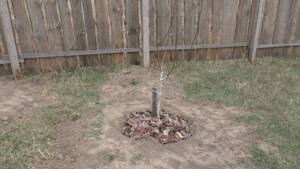
Soil mulching option
You can drive a support peg into the center of the planting hole, which will rise 0.5 m above the ground. A seedling is tied to a peg after planting.
A mound of soil mixture is poured near the support peg. A tree is placed on a mound and the roots are straightened. When covering the roots with soil, the trunk of the seedling must be shaken periodically to fill all the voids.
Having filled more than half of the hole, you can pour a bucket of water with the root there. Then continue pouring the soil mixture. When finishing planting, you need to check that the root collar of the seedling rises 3-5 cm above the ground.
At the very end, you need to carefully compact the earth around the tree trunk. Also form a circle with a diameter of 50 cm around the pear from an earthen bank approximately 5 cm in height. Pour a couple of buckets of water inside the circle (even if it was raining at the time of planting).
The final stage is mulching and fixing the trunk to the support (do not pinch!). The soil inside the earthen roller can be mulched with whatever is on hand.
It is important to leave 8-10 cm of unmulched soil around the central shoot. Otherwise, rotting of the part of the trunk where there is contact with the mulch may begin.
Planting in spring
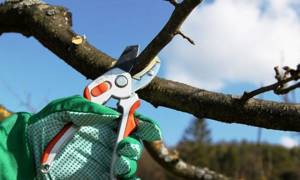
Trees need to be pruned regularly
Planting in spring is practically no different from autumn. It is advisable to cut the roots to 10 cm. Additionally, you can dip the roots in a clay mash.
After planting, the leaves, if any, are carefully torn off. It is advisable to trim off the branches of 2-3 year old seedlings. All these procedures can be done during autumn planting.
Ripening time
Early varieties ripen towards the end of July (in warm regions) and in August (in cold regions). Of greatest interest are:
- Victoria;
- Prominent;
- Severyanka;
- Cathedral;
- Skorospelka from Michurinsk;
- Chizhovskaya;
- August dew;
- Irista.
The fruits must be collected immediately, without leaving them on the branches for a long time. They cannot be stored for long periods of time; in a cool place they remain in good condition for a maximum of 2-3 weeks. The advantage is not only early ripening, but also good taste characteristics (4.4-4.8 points).
Related article:
The sweetest varieties of pears

August dew
Mid-ripening pears are harvested in September or early October. The trees have good resistance to frost. The crop remains on the branches for a short time; the risk of shedding increases at high air temperatures. The shelf life in cool storage is 45-70 days, and at room temperature - about a month. The peculiarity of autumn varieties is that the taste improves during storage. Representatives of this group:
- Nerussa;
- Autumn Dream;
- Simply Maria;
- Thumbelina;
- Conference;
- Veles;
- Muscovite.

Late (winter) pears are harvested in mid-autumn and stored - commercial quality is maintained until January-April. Optimal storage temperature: +3…+5 degrees. Popular with gardeners:
- Extravaganza;
- November;
- Otradnenskaya;
- Novella;
- Nika;
- Williams winter (Cure);
- Belarusian late.
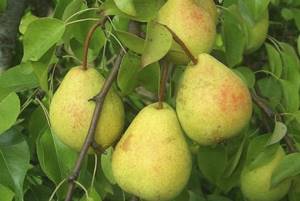
Belarusian late
Where to plant pears?
If you follow all the rules for planting pears, the chance that the tree will successfully overwinter and bring a rich harvest increases. Due to the fact that pears love warmth, it is recommended to plant spring and autumn varieties of pears in sunny areas sheltered from sharp gusts of wind.

Trees do not tolerate moisture, so when choosing a location, it is worth considering that pears will not survive stagnant water. The ideal place for planting is a hill under which groundwater does not flow. The seedling will not take root on clay soils either.
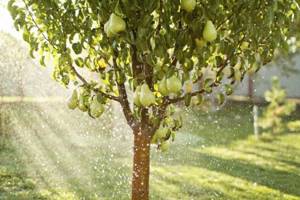
In the vicinity of other trees, pears are unpretentious; they will easily take root next to apple trees. The only tree next to which the pear will not be very comfortable is the mountain ash. This is explained by the fact that they are susceptible to attacks by the same pests, and if one tree is infected, the second will also suffer.
Size
Large-fruited varieties in most cases are characterized by stable fruiting. The weight of the fetus can reach 500 g, but the average is usually more modest (from 200 g). Representing the group:
- Marshal Zhukov - up to 560 g;
- Large-fruited Susova - from 200 g;
- Bere Ardanpon – from 200 g;
- Marianna – up to 350 g;
- Silk King – up to 400 g;
- Large-fruited – up to 500 g;
- Space – up to 550 g;
- Vidnaya - up to 540
Related article:
Proper planting of pears on the site
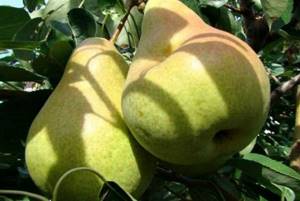
The most numerous is the medium-large varietal group. Weight 1 pc. is 80-200 g. The advantage is increased fertility. Representatives:
- Talgar beauty, Melting – up to 200 g;
- Lada, Chizhovskaya - up to 120 g;
- Annushka, Muratovskaya, Dicolor, Ilyinka (140-150 g).
Small-fruited varieties are not very popular. They are mainly used for processing - they are used to make juices, confitures, and jam. Weight 1 pc. is 30-80 g. Of interest to gardeners are:
- Limonka;
- The first swallow;
- Moscow;
- Not big;
- Uralochka;
- Siberian;
- Thumbelina.

Thumbelina
Pests, diseases and treatment of pear
Despite the resistance of modern pear varieties to a number of dangerous diseases, bad weather conditions and failure to comply with preventive measures can lead to tree disease:
- scab
on pears it affects young branches, leaves, and ovaries of pears with characteristic dark spots 2-4 cm in diameter. The fruits become smaller and become tough.
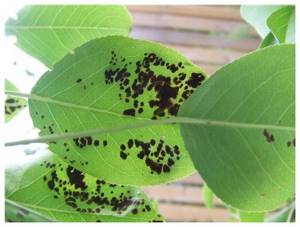
- stem rot
occurs from frost or sunburn, poor care or lack of nutrients. The bark of the pear tree turns dark red and the tree dries out.

- powdery mildew
a fungal disease of pear, characterized by a whitish coating covering the branches, leaves and flowers, which leads to the fall of the ovaries.

- pear sucker
feeds on the cellular sap of trees, causing the buds, leaves or buds of the pear to fall off.

- pear moth
lays eggs on pear fruits, and the emerging caterpillars devour the pulp.
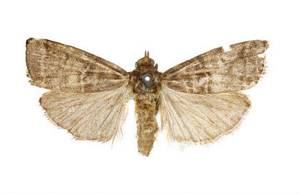
Timely treatment of pears with insecticidal preparations, colloidal sulfur, Bordeaux mixture, as well as sanitary pruning and burning of affected pear shoots and foliage help prevent the spread of the disease and in most cases save the plant.
Economic use
Fruit varieties are divided into:
- canteens (dessert);
- technical;
- universal purpose.
For the dessert type, the crop has an excellent presentation and good taste characteristics, it is stored for a long time, and can withstand transportation with virtually no losses. The product is mainly consumed fresh. Best representatives:
- November;
- Talgar beauty;
- Marble;
- Bartlett Red Rosey;
- Bronze;
- Maria;
- Dawn;
- Dessert;
- Banquet;
- Quiet Don.
Related article:
Pruning a pear in the fall: 7 useful tips to help ensure a good harvest

Banquet room
Representatives of the technical group:
- Orlovskaya summer;
- Firefly;
- Granddaughter;
- In memory of Yakovlev;
- Hanging.
They do not have high commercial qualities and do not last long, but they have a good taste, so they are used for processing.
Universal purpose are:
- Bere Russian;
- Lada;
- Podkumok;
- Zoya;
- Hera;
- Otradnenskaya;
- Elena;
- Dicolor;
- Academic.

The fruits are equally suitable for fresh consumption and processing.
Some pear trees are used for landscaping. Their fruits are inedible or of no value. After the leaves fall, they remain on the branches, the green color changes to brown, almost black.
- Callera Chanticleer - the crown has a columnar shape, in the spring clusters of flowers add decorativeness, in the fall the foliage takes over the baton, acquiring an orange and yellow tint;
- Beach Hill - the crown is pyramidal, the flowers are collected in inflorescences, in April-May they become a real decoration of the tree, the elliptical leaves turn bright yellow or orange in the fall;
- Willow - the crown is spreading, with drooping branches, the leaves are pubescent, narrow, similar to willow, large white flowers are collected in inflorescences.
Related article:
Winter-hardy pear varieties
Summer pear varieties (early)
Summer varieties can be enjoyed at the end of summer. They are juicy and sweet, but do not last long.
Pear Vidnaya
The trees grow tall with a spreading crown, which over time takes on a pyramidal shape. Fruiting occurs 4-5 years after planting. Self-fertile species. Plants have high resistance to disease and frost.
The harvest ripens in August. Peculiarities:
- taste: delicate, sweet and sour;
- pulp: oily, fine-grained structure, creamy;
- peel: dense, but not hard, green and smooth;
- fruits weighing 160 g have a classic, elongated shape.
The fruit does not store well and may fall off when ripe on the tree, so the fruit is harvested a week before full ripening.
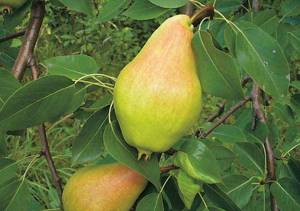
Prominent
Summer pear – Bryansk beauty
The plants grow short and have a narrow pyramidal shape. Self-fertile trees begin to produce fruit after 3 years. They can withstand frosts down to -38, but do not tolerate drought well - the fruits begin to taste bitter. High resistance to scab and pests.
The harvest ripens in September. Features of this type of fruit:
- taste: delicate, sweet and sour;
- pulp: creamy, caramel-colored, aromatic, juicy and buttery;
- peel: dense, but not hard, green with brown spots and blush;
- fruits grow up to 260 g.
Does not store well - maximum two weeks in the cold.
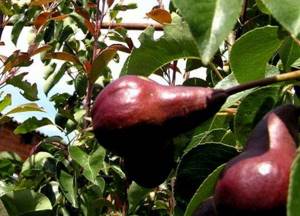
Summer varieties of pears - Bryansk beauty
Pear variety Clapp's Favorite
The pear grows quite tall, and the tree develops especially quickly at a young age. The crown is not dense in the shape of a pyramid. The branches become drooping. Fruiting from the 8th year of cultivation. The plant is unpretentious and tolerates frost and drought well. But it is susceptible to diseases and pests.
The harvest ripens in late July-early August. Features of Clapp's Favorite:
- taste: sweet, melting in the mouth;
- pulp: creamy, tender, juicy, wine-sweet, aromatic;
- the peel is tender, yellow-green with a blush, smooth, slightly bumpy;
- the fruits grow up to 240 g and are ovoid.
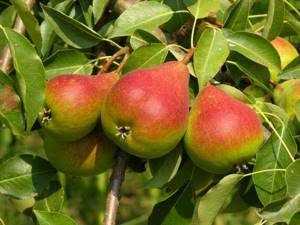
Clapp's Favorite
Pear Sverdlovsk
The compact appearance is highly resistant to frost and drought, as well as to fungi and pests. Plants can withstand temperatures down to -38 degrees. The first harvest can be harvested within three years after planting.
The fruits ripen in mid-September to early October. Features of Sverdlovsk:
- taste: sweetish with slight sourness;
- pulp: aromatic, melting in the mouth, yellowish in color, slightly oily without grains;
- smooth green peel;
- weight – up to 180 g.
Once fully ripe, the fruit does not fall from the tree. They store well and for a long time and can be transported.
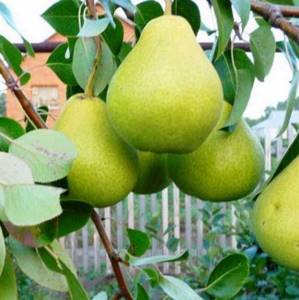
Sverdlovchanka pear variety
Early pear – Rogneda
An early autumn species that ripens in the second half of August. The trees produce good yields. Fruiting in 3-4 years of cultivation. They grow compactly and perfectly decorate the garden plot. They can withstand severe Siberian frosts, so they feel great in the middle zone.
Pears grow spherical, of average size up to 160 g. The flesh is yellowish, tender with a semi-oily structure. The taste is spicy, slightly nutmeg without sourness.
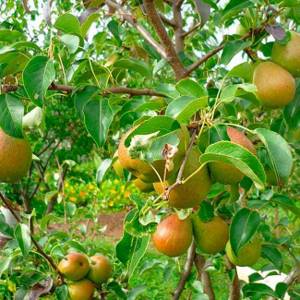
Rogneda
Carmen pear variety
An unusual variety that looks like apples. The peel is red with rare brown spots. The trees grow small - up to 100 cm in height. The crown is dense and compact.
The fruits ripen in late July-early August. They taste sweet, not tart, with semi-oily, dense flesh. There is a slight waxy coating on the surface.
The plant is highly resistant to diseases, such as scab. They are not stored for long, but tolerate transportation well.
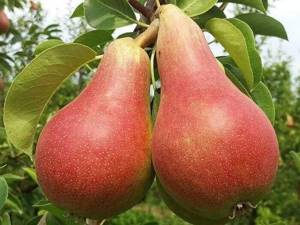
Carmen
Frost resistance
Frost-resistant varieties are suitable for growing in risky farming areas. During the selection process, the Ussuri subspecies was used, which is considered the most winter-hardy. Breeders managed to breed trees that can withstand severe frosts and these are:
- Uralochka;
- Bessemyanka;
- Tyutchevskaya;
- Marble;
- Kyrgyz;
- Lel;
- Clapp's favorite;
- Muscovite;
- Tonkovetka.

For warm regions, any form is suitable, including those that cannot withstand winter frosts:
- Hydrangea;
- Morning freshness;
- Kieffer's seedling;
- Enchantress.
Pear: harm and contraindications
- For elderly and senile people who have a history of any nervous system disorders or gastrointestinal diseases (especially stomach ulcers), sour or too tart varieties of pears are absolutely contraindicated.
- Pear pulp contains a lot of hard fiber, which irritates weakened, diseased intestines and takes quite a long time to digest.
- Dried pear fruits are quite tasty, but very high in calories, so those who want to lose weight should not include them in their menu.
Height
Tall forms are not very popular, since at a height of more than 6 m it is difficult to fully harvest the crop and form a crown (it begins at the level of 1.5-1.8 m). They have a high standard:
- Apple-shaped;
- Fabulous;
- Children's;
- Gimrinskaya;
- Dessert luxury;
- Larinskaya;
- Beauty Chernenko;
- Otradnenskaya;
- Simply Maria.
Related article:
Pear Skorospelka from Michurinsk
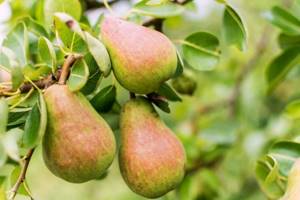
Beauty Chernenko
The most numerous is the medium-sized group:
- Petrovskaya;
- Lyra;
- Goryachevodskaya;
- Shihan;
- Dressy Efimova;
- Firefly;
- Oktyabrskaya;
- Central Russian.
Low growing forms:
- Otradnenskaya;
- Belarusian;
- Alyonushka;
- Severyanka;
- Mashuk;
- Duchess summer;
- Chizhovskaya;
- Admiral Gervais.
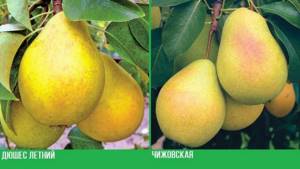
Dwarf trees are very popular among summer residents - fruiting begins already 3 years after planting. Thanks to its low height (up to 3 m), harvesting is easy and there are no losses. For cold regions, seedlings grafted onto shadberry or chokeberry are suitable, for warm regions - onto any rootstock (including quince). The quality of the fruit is no worse than that of other forms. Representatives of the dwarf group:
- Grand Champion;
- Bere Gardi;
- Ferdinand;
- Veles;
- Parisian.
Important to know: How to recognize pear diseases from photos
Types of pears, names, descriptions and photographs
The modern classification includes 33 species of pear, divided into 2 botanical sections - Pashia and Pyrus. Below are several varieties:
- or wild pear (Pyrus communis, Pyrus domestica )
large shrub or tree up to 20 meters high. This type of pear gave rise to most of the cultivated varieties grown in the temperate climate zone. In nature, the wild pear is distributed from Eastern Europe to Western Asia. It is considered a good honey plant and a valuable dietary product. Varieties of common pear:
- Pyrus communis L. subsp. Communis
- Pyrus communis L. subsp. Caucasica – Caucasian pear
- Pyrus communis L. subsp. Pyraster – Forest Pear

Common or wild pear (lat. Pyrus communis)
- wood pear (Pyrus communis subsp. pyraster)
subspecies of the common pear. It grows in the form of low shrubs (up to 4 meters) and trees growing up to 20 meters. The forest pear gave birth to hundreds of cultivated varieties, and thanks to its durable wood, it is successfully used in carpentry and turning. This tree grows in the forests and forest-steppes of Central and Eastern Europe.

- Boissier pear (Pyrus boissieriana)
drought-resistant, rare type of pear, grows to a limited extent in Azerbaijan and Turkmenistan, where it is listed in the Red Book. It is also found in northern Iran. Used as a rootstock and hybridization.

- pear-leaved pear (Pyrus pyrifolia)
drought-resistant, not demanding on soil, has a trunk height of up to 20 m, varietal plants grow up to 6 m. The pear-leaved pear grows in the countries of Central Asia and the Russian Far East. It is widely used in agriculture, has a high decorative purpose, and in China is revered as a sacred tree.
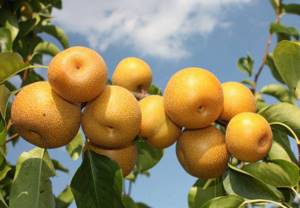
- Ussuri pear (Pyrus ussuriensis)
grows up to 15 meters in height and is characterized by increased frost resistance, due to which it is used in breeding as a source material. The Ussuri pear is widespread in the Far Eastern region of Russia, China and Korea.

- pear (Pyrus elaeagrifolia)
It is characterized by a small height of up to 10 m and high resistance to frost (up to -25 degrees). Small pear fruits are used in cooking, and the trees are used as a rootstock and for gardening. In the wild, the shaggy pear is found in the Crimea and the Caucasus.
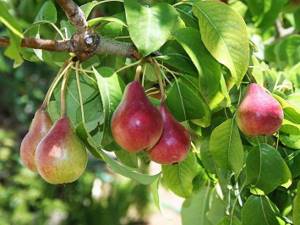
- willow pear (Pyrus salicifolia)
This type of pear reaches a height of 8-10 m. The crown of the willow pear is lush, with openwork foliage and early mass flowering. The fruits are small and inedible, so the pear is mainly used as a rootstock for new varieties and as an ornamental plant.

Crown shape
Pyramid plants need shaping and pruning. Representatives of this type:
- Yuryevskaya;
- Kabardinka;
- Decor;
- Record holder.
Related article:
Fruitful varieties of columnar pears
The rounded shape of the crown is not suitable for small areas; the tree needs a lot of light and creates a large shading area. In addition, it needs annual pruning. The most famous:
- Gimrinskaya;
- Ilyinka;
- Kupava.

The shape of the crown is finally formed closer to 10 years.
Columnar pears are the most compact form, taking up minimal space in the garden. The tree stretches to a maximum of 2.5 m, the branches grow weakly, so its shape resembles a column, which is the basis for the name. Fruiting occurs already 2-3 years after planting. The ovaries are located near the trunk. Frost resistance of this form is good, the taste of pears is at a high level. The only drawback is that the lifespan does not exceed 10-12 years. Representatives of this type of plants:
- Tenderness
- Sanremi
- Carmen;
- Sapphira.
Related article:
Proper planting of pears on the site
Pruning pears
Pears need regular pruning as they require large amounts of sunlight to fully develop. Also, pruning allows the pear not to waste energy on growing young shoots, but to use all the useful microelements for the ripening of the fruit.
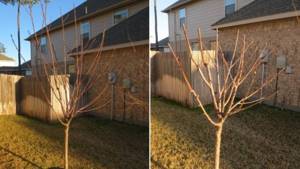
- Olives - what is their specialty? Useful properties for humans, 120 photos of fruits
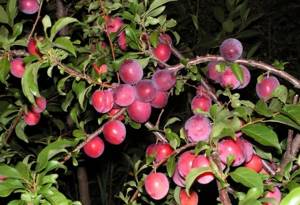
Cherry plum is the best variety of fruit. 115 photos and a detailed overview of all the properties of cherry plum for humans.
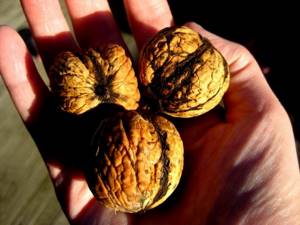
Tree nut (walnut) - beneficial properties. How to plant and care for a tree (110 photos)
And this has a positive effect on the quality of the crop. And it will be easier and more convenient to harvest if you do not allow the tree to grow tall, and it is worth noting that pears are quite tall trees.

Taste characteristics
Sweet varieties are in greatest demand, such as:
- Children's;
- Dessert;
- Honey;
- Autumn sweet.

It has been noticed that the sweet pulp is easier to digest and does not cause stomach upset. The sweet and sour refreshing taste is inherent in pears:
- Original
- Karataevskaya
- Firefly;
- Success.
The tart, astringent taste occurs as a result of the increased content of tannins (especially in the peel). Group representatives:
- Whiteleaf;
- Siberian;
- Pervomayskaya.
The taste of the pulp is affected not only by the variety and quality of tree care, but also by weather conditions.
Care
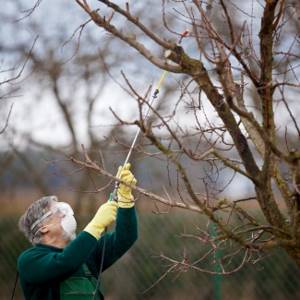
Attention to wood is the key to a high harvest in the future
The pear plant is whimsical and requires constant care.
The range of tree care measures includes:
- Regular watering.
- Removing weeds around the tree.
- Mulching the soil.
- Feeding.
- Pest protection.
- Prevention and treatment of diseases.
- Crown formation.
- Cleaning up carrion and fallen leaves.
- Warming for the winter.
If everything is done correctly, after 5-7 years the tree will grow 8-15 meters (depending on the variety). And, of course, it will begin to bear fruit to the delight of its caring owner.
the spring , the insulation is removed from the trees, the soil around the trunk is loosened, and nitrogen fertilizers are applied. Before the sap begins to flow, damaged, diseased branches need to be pruned. Like any other tree in the garden, the pear must be treated to destroy pests and pathogenic microorganisms.
In summer , care consists of watering. And also in thinning pruning of the crown, if necessary, to prevent thickening.
In the fall you will have to do the same procedures as in the spring. Sanitary pruning, fertilizing, whitewashing, and prevention of pests and diseases will be required. The last autumn months are a good time to prepare trees for winter.
Watering seedlings and mature trees
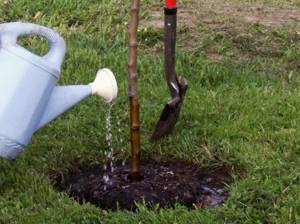
Proper watering
It is necessary to water the soil around the tree both during the planting process and during spring and summer. The norm is at least 3 liters of water per tree (preferably per 1 sq.m.).
In the first year after planting, the tree is watered once every 7 days. Then the frequency of watering is reduced to once every 14 days.
If the summer is very hot and dry, it is advisable to water the seedling more often.
The best method of watering is sprinkling. That is, it is advisable to install an installation that will simulate rain. Watering should be done in the evening, after the heat has subsided.
If installing a sprayer is not possible, there is a budget option for watering. A groove about 15 cm wide is dug around the trunk. Water is poured into this groove, but not cold, but left to sit for a day in a sunny place.
After each watering, the soil is loosened to ensure oxygen supply to the roots and re-mulched. The main thing is that the soil around the trunk does not dry out or become crusty. All weeds that grow under the crown of a young tree must be removed.
Treatment against pests and diseases
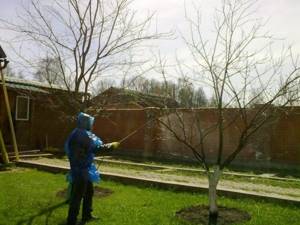
Treating wood against diseases and insects
Pears, like other garden trees, are susceptible to various diseases. This could be scab, stem rot, powdery mildew and other diseases. Trees are also often damaged by leaf rollers, green aphids, fruit moths, pear borers and pear mites.
Biological products or chemicals can be used to protect plants from diseases. It is better to give preference to biological products. Even though more such treatments are needed compared to chemicals.
Biological products are used throughout the season - from the moment the leaves bloom until the harvest. Some gardeners even use such products to process harvested fruits to ensure a long shelf life.
If you use chemicals, you can limit yourself to 2-3 treatments. But the slightest mistake in dosage, failure to follow instructions or safety measures, and the consequences can be dire. You can poison not only a tree, but also the soil, other plants, animals and family members.
To protect against bacterial, fungal and viral infections, you can use the drug Fitosporin-M, Gaupsim or other biological products. For protection against insects - Actofit, Bitoxibacillin or Fitoverm.
Treatment can begin when the air warms up to 16-18 degrees. In cold and heat (+32 and above), biological products are ineffective. The results of the treatment will appear in a week (if there is no rain). The procedure can be repeated after 1-2 weeks.
Organic fertilizers and green manures
The best fertilizers for pears are organic (humus, compost), mineral (nitrogen, phosphorus, potassium) and green (green manure). You can make your own organic fertilizer by creating a compost heap. Properly prepared compost can provide a tree with many of the necessary substances for rapid growth and fruiting.
Organic fertilizers are applied once every 3-4 years.
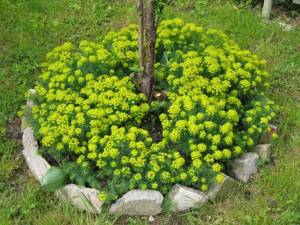
Instead of mulch, you can plant other plants around the tree
There is also another option on how to feed a tree with minimal financial investment. You need to buy seeds of any green manure, for example, alfalfa, lupine. You need to sow green manure directly in the garden.
Advantages of planting green manure under pears:
- In autumn or spring, the soil is dug up, green manure is embedded in it, and compost is added as necessary - the tree receives additional nutrition. Only green manure must be sealed with extreme caution so as not to damage the roots of the tree, which are close to the surface of the earth.
- The grown alfalfa is regularly mowed in spring, summer and autumn and used as food for herbivores. Or sent to compost.
- The soil around the tree is free of weeds, everything looks neat.
- There is no need to mulch or loosen the soil after watering.
However, it is worth noting that there is a whole science that green manure harms neighboring plants. Therefore, every gardener chooses between mulching and green manure, based on his personal beliefs. But organic matter in reasonable quantities and applied on time will definitely not harm pears.
Fertilizing with mineral fertilizers
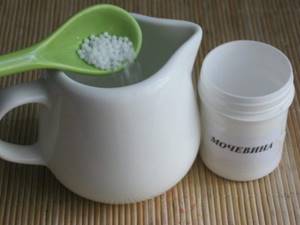
Urea is one of the preparations for feeding
Pears need fertilizers, but in small quantities. Some gardeners recommend not applying mineral fertilizers in the first year or two after planting. Others believe that feeding is mandatory in the first 2-4 years.
In the future, there are several fertilizer application schemes - in early spring every year, during the season every year, or in case of obvious starvation.
The signs of such fasting are quite obvious:
- The tree is stunted - up to 40 cm per year.
- The leaves are light (with the exception of pears with such varietal characteristics).
- The leaf blade is poorly developed.
- The tree does not bear fruit.
It is advisable not to let the tree go hungry, but still feed it according to the following scheme:
- In early spring (before the buds swell) - spray the pear with a urea solution.
- If you did not have time to complete the first step before the sap flow begins, we apply nitrogen fertilizers directly into the soil. This can be a solution of urea (80-120 g/5 l of water/1 tree), chicken droppings, saltpeter (30 g/1 sq.m.).
- Apply fertilizer in May after flowering. For this purpose, prepare a solution of nitroammophoska, proportion 1 to 200. One tree will require 3 liters of solution.
- Second half of June, July – foliar fertilizing with nitrogen.
- In early August, phosphorus and potassium are applied to mature trees.
- Mid-September - trees and soil are treated with urea as in spring.
In the fall, young plants are fed for the last time with wood ash (150 g/1 sq.m. for digging to a depth of 10 cm). After this, you can start preparing the trees for wintering.
Preparing trees for winter

Option for covering annual seedlings
After the leaves fall, they need to be collected and taken outside the garden. Healthy leaves can be composted. It is advisable to burn the sick.
All young pear seedlings must be protected from frost. You can tie them with pine branches with the needles down. And then additionally wrap it in burlap.
Also, the shoots of young pears need to be collected in a bunch, pressed to the trunk and wrapped with rope. If the tree has already grown so much that its branches cannot be collected into a bunch, you need to periodically shake off the snow caps.
Older trees need to be protected from rodents. To do this, the pear trunks are wrapped in fabric, which is pre-impregnated with rodent-repellent solutions.
When snow falls, it needs to be raked up to the tree trunks, thus creating additional protection from frost.
Color and shape
Most garden pears have an elongated oblong shape, widening downward. Round fruits are less common. Of interest in this category:
- Rogneda:
- Rossoshanskaya late;
- Red-sided;
- Olivier de Serres.
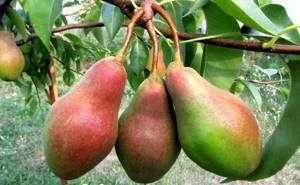
Usually the pear flesh is white or cream. A rare exception are pears with brown flesh: Chernomyaska gall, Sharamilap. Most fruits have green or yellow skin with or without blush. In some varieties, when fully ripe, it darkens to brown. Against the background of the “competitors” in the garden, the purple fruits Starkrimson, Williams red, Naryadnaya Efimova, and Sapphira stand out favorably. They not only look impressive, but also delight with excellent taste.
Related article:
How to deal with scab on apple and pear trees
Description, characteristics and photographs of the pear
Most members of the pear genus are deciduous trees. Under favorable growing conditions, the height of the trunk can reach 25 m, and the diameter of the crown is 5 m. Wild pear species have a dense pyramidal or rounded crown shape. Pear leaves are wide, ovoid, dark green in color with a glossy top, arranged spirally in 5 rows.
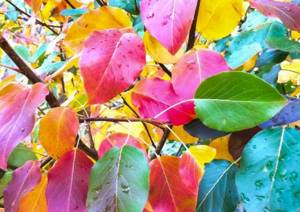
Pear flowers are white, rarely pinkish, five-petaled, collected in umbrella-shaped inflorescences of 3-9 pieces.
The ovaries of the pistils are fused with the receptacle and have the shape of a cup.

The fruit of the pear in most species is oblong, widened downwards, although there are varieties with spherical fruits resembling an apple.
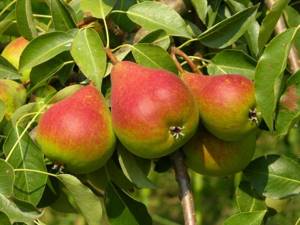
Pear wood is hard, dense, with a fine texture and barely noticeable growth rings. Due to the presence of special “stone cells”, dried raw materials are quite easy to process. Treated with black stain, pear wood perfectly imitates expensive ebony wood, and when exposed to hot air it turns red. As pear wood naturally ages, it acquires a distinctive amber color.
The average lifespan of a pear is 150-200 years, although some types of pear trees live up to 300 years.
Pollination method
For the most part, pears are self-sterile; trees of certain varieties must grow next to them. For example, for Cure the pollinators are Bon Louise and Deccanca, for Bere Bosc - Saint-Germain and Williams. Self-fertile pears are a rare and highly valued phenomenon. This quality becomes especially important if, due to bad weather, there are few pollinating insects in the garden.
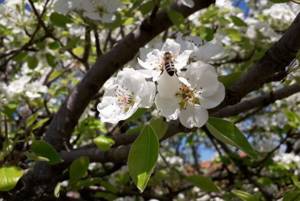
Best representatives:
- Banquet;
- Marble;
- Rogneda;
- Simply Maria;
- Chizhovskaya.
The benefits of pears for the body. Vitamins and minerals in pear
Pear contains vitamins A, E, C, K, group B in quantities superior to many other fruits, as well as a large amount of minerals: potassium, calcium, phosphorus, sodium, folic acid. In folk and official medicine, pear is considered a recognized dietary product and a natural source of energy. The unique mineral composition and beneficial properties of pear help fight many diseases:
- potassium normalizes heart function, reduces cholesterol levels, improves metabolic processes;
- calcium , phosphorus and magnesium strengthen the structure of bone tissue;
- sodium maintains water-salt balance and pancreas function;
- folic acid improves the hematopoietic system;
- the anti-inflammatory antibiotic arbutin reduces the risk of prostatitis;
- Tannins stop diarrhea.
Pear fruits contain fructose and a small amount of calories (42-58 kcal/100 g), therefore they are invaluable as a dietary food and are recommended for diabetes.
